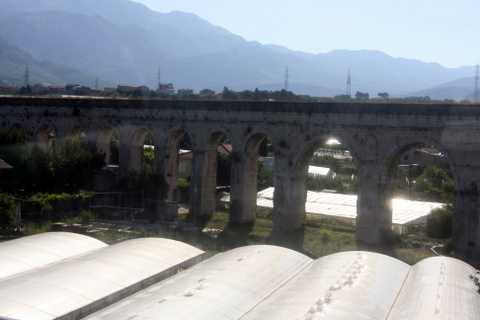Home › Forums › Early Modern Europe › What is it?
- This topic has 2 voices and 6 replies.
-
AuthorPosts
-
August 18, 2013 at 6:52 pm #3582
 scout1067Participant
scout1067ParticipantANybody have any ideas what the attached pictures are of?Hint: it is in a castle (Klis, outside Split, Croatia to be exact) and few of these remain anymore and certainly very, very few that could still be used. Sorry about the bags of concrete, the castle is being renovated.I just got back from two weeks in Croatia and more pictures will follow with cryptic quizzes attached.
August 18, 2013 at 7:57 pm #29058 PhidippidesKeymaster
PhidippidesKeymasterI am guessing you are asking what room do we think it is? Given that the room appears to be on a corner (at least from what I can see in the picture), and that there's a hole toward the bottom with a lip near it defining a space where liquid could be collected (and the fact that you even posed this question in the first place), I'm going to guess it was a bathroom.
August 18, 2013 at 8:29 pm #29059 scout1067Participant
scout1067ParticipantYes, it is the toilet for castle Klis. The waste just ran down the side of the mountain.There are actually very few original castle toilets still around, most have been bricked up with time and the installation of modern plumbing.
August 18, 2013 at 9:21 pm #29060 PhidippidesKeymaster
PhidippidesKeymasterOk, so a few questions- How old is the castle?- Is the castle in a semi-ruined state? (e.g. exposed to the air)- Did they explain more about how the bathroom worked? This is actually a fascinating topic (to me at least). Was there some type of seat (perhaps moveable) that was used as the "throne" for the bathroom? And that hole seems awfully large....I wonder if it was smaller at one point in time. Also, I imaging that it was customary to "flush" the toiled by bringing a bucket of water following use. Otherwise, the side of the castle would look even more awful than it did.
August 19, 2013 at 5:06 am #29061 scout1067Participant
scout1067ParticipantThe castle was built in the late 17th century by the Venetians to defend the coastal plain against the Truks. There was zero information about the bathroom. The hole looks out over a 75-100 foot cliff. They actually did not not explain anything about the bathroom. I figured out what it was because the offal heap is still there. There were no facilties to rinse it out and I imagine they just squatted over the hole to do their business. The side of the mountain probably look every bit as nasty as you can imagine, the rock is still stained from the toilets use.It actually reminded me of a stone version of the wooden latrines we found in 1996 when we took over the Mt Vis defenses in Bosnia from the Serbs. The Serbs were shocked when the first thing we did was burn all their latrines and put burn-out latrines in place.
August 19, 2013 at 2:40 pm #29062 PhidippidesKeymaster
PhidippidesKeymasterThe reason I thought there may be a way to “flush” it is because I recall reading an article about a Roman bathroom in which the bathroom floor where the seat was was on a slight slope, so afterwards water could be poured on the floor and it would carry waste underneath the wall and away from the area. In the castle, I imagine something similar took place – even if it was a bucket of water thrown on the walls/floor after a person went. I admit that people throughout history put up with many more bad smells than we experience today, but I also think that they did what they could to reduce them when possible.
August 19, 2013 at 6:28 pm #29063 scout1067Participant
scout1067ParticipantThe Romans had running water. They used toilets that had a constant stream of running water below the seat. Running water did not reappear in widespread use in Europe until the 19th century. On another note, the city of Split is still partially supplied with water by the aqueduct Diocletion had built to supply his palace in the 4th Century. It was renovated in the 1800's and is still in use. You can see part of where it runs above ground as you drive out of the city.
 August 19, 2013 at 6:35 pm #29064
August 19, 2013 at 6:35 pm #29064 PhidippidesKeymaster
PhidippidesKeymasterThe Romans had running water. They used toilets that had a constant stream of running water below the seat. Running water did not reappear in widespread use in Europe until the 19th century.

I was thinking of a specific Roman one, though, which was not connected to a constant stream. I am pretty sure that they had to take a bucket and "flush" it manually. Something similar could be achieved in a castle so long as the water were hoisted to the upper levels of the building where the toilets were located.
-
AuthorPosts
- You must be logged in to reply to this topic.



